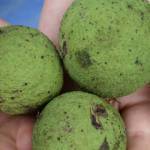Black Walnut Poisoning in Horses

Black walnut trees are common in forests and farms, particularly in the eastern two-thirds of the United States. Trees can have large canopies with long, toothed leaves and rough brown bark. Walnut casings are yellowish-green and turn brown as they ripen. Unfortunately, black walnuts and the wood from black walnut trees are toxic to horses. A major concern of black walnut toxicity is laminitis and founder, but other symptoms include depression, stocking up, colic, elevated heart rate and body temperature, and swelling in the neck and chest.*
A chemical toxin known as juglone is found in the roots and wood of black walnut trees and was thought to be the poisonous culprit.** However, extracts from black walnut and heartwood that did not include juglone still caused laminitis under experimental conditions.+ Black walnut extract has also been shown to cause severe inflammation in the colon and may contribute to the inflammatory cascade that causes or contributes to the development of laminitis.++,§
Because of the sensitivity of horses to black walnut, horses should not be bedded on shavings from the black walnut tree. The shavings from black walnut trees appear very dark compared to the lighter pine shavings. Bedding that contains as little as 5-20% black walnut shavings can cause illness.*
If black walnut trees are present in horse pastures and removal is not an option, it is best to create a physical barrier around the trees to keep horses safe. A barrier can help prevent horses from chewing on bark and minimize exposure to the black walnuts.
Black walnut trees can also be removed from pastures and fencelines. “If a black walnut tree has been removed, be mindful of any sawdust that has been left behind. Sawdust should be removed so horses cannot stand on or accidentally consume it,” said Katie Young, Ph.D., a nutritionist for Kentucky Equine Research. She also suggests removing any fallen branches as soon as possible and cleaning up any walnuts that may have fallen within reach of curious horses and ponies.
Any suspected exposure to black walnut warrants an immediate call to the veterinarian. Washing the affected areas, especially the hooves and legs, with soap and water is also recommended.
Don’t know an ash from a black walnut? A maple from an oak? Consider hiring an arborist or other professional to scope out your pastures and surrounding areas for problematic trees. Local extension personnel employed by land-grant universities may also be able to help.
*Martinson, K., I. Hovda, M. Murphy, and P. Weicherding. 2021. Black walnut: A toxic horse bedding. University of Minnesota Extension, publication no. 1320810.
**Skelly, C. 2020. Can my ponies be under a black walnut tree for shade? Extension Horses Knowledge Base, no. 662066.
+Belknap, J.K. 2010. Black walnut extract: An inflammatory model. Veterinary Clinics of North America: Equine Practice 26(1):95-101.
++McConnico, R.S., A.M. Stokes, S.C. Eades, and R.M. Moore. 2005. Investigation of the effect of black walnut extract on in vitro ion transport and structure of equine colonic mucosa. American Journal of Veterinary Research 66(3).
§Hurley, D.J., L.J. Berghaus, K.A.E. Hurley, and J.N. Moore. 2011. Evaluation of the in vitro effects of aqueous black walnut extract on equine mononuclear cells. American Journal of Veterinary Research 72(3).








